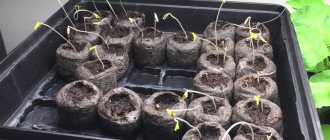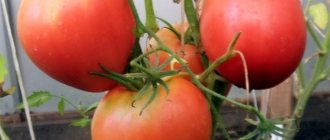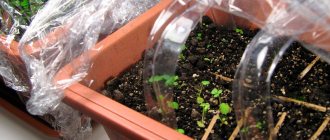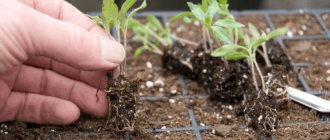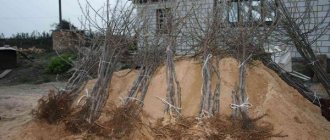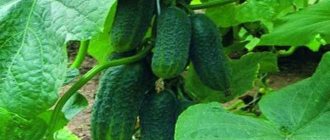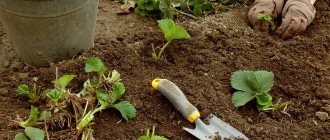When growing cucumbers, it is important not only to use the correct agricultural practices, but also to place the seedlings in suitable soil. As part of preparing a greenhouse or open beds for planting cucumbers, it is necessary to determine the composition and acidity of the soil and, if necessary, improve it by adding mineral or organic fertilizers.
Click on the map to enlarge
Types of soils in Russia
Not all types of soil that can be found throughout the country are suitable for growing cucumbers.
- The most acidic are saline soils, solonetzes and carbonate soils. pH parameters are in the range of 7.5–9.5. In summer, they warm up to 25⁰C in the upper layer. Such soils are practically unsuitable for growing cucumbers; to normalize them, it is necessary to enrich the top layer with humus, release salts, and get rid of alkali.
- Such types of soil as chestnut soils, chernozems, and gray soils have optimal acidity. Their acidity parameters are in the range of 6.5–7.5 pH. In summer they warm up to 15⁰C, require virtually no adjustment of composition, and are suitable for cucumbers and almost all other garden crops.
- In permafrost-taiga soils, acidity indicators vary greatly and depend on the region, ranging from 4.5–7 pH. They do not warm up due to low temperatures and are not suitable for cucumbers. Sometimes they are used in greenhouses and greenhouses - in this case lime is added to them.
- Gray forest soil has a pH range from 4.5 to 6.5. It warms up well and sometimes needs minimal liming.
- Soddy-podzolic and podzolic soil varieties are not suitable. They have low acidity - in the range of 4.5–5.6 pH, warm up to only 8–10⁰С, and always need deacidification, shelter to increase the temperature and additional feeding with humus.
- Swamp-podzolic and peat-podzolic soils are not suitable for cucumbers. They are slightly acidic, the pH level is in the range of 3–5, the earth cools very much at night and overheats during the day. Measures against temperature fluctuations and additional liming are necessary.
Cucumbers can be grown in neutral or slightly acidic soil. In the latter case, additional lime is added to normalize the composition.
Seed selection
The primary goal for any summer resident is to choose the right seeds for planting. Here the following factors must be taken into account: the landing site, the climatic and weather conditions of your region and your own wishes.
If you decide to plant cucumbers in open ground, then early-ripening varieties may be the best option. They bear fruit earlier than usual, so they can be intended both for personal consumption and for sale.
If you decide to grow cucumbers in a greenhouse, then it is best to choose those varieties that are parthenocarpic and self-pollinating. By choosing pollinated varieties, you risk losing the entire harvest, because it is unlikely that bees will move freely in the greenhouse for subsequent pollination.
The best pollinated varieties: Zhuravlenok (hybrid), Golubchik (hybrid), Rodnichok (hybrid). The best self-pollinated varieties: Cheetah (hybrid), Orpheus (hybrid), Amur (hybrid). The best parthenocarpic varieties: Picnic (hybrid), Premium (hybrid ), Pyzhik (hybrid).
You can read more about the varieties and their unique advantages in the article about the best varieties of cucumbers for all types of soil and climatic conditions.
Ideal soil parameters
Cucumbers grow wild in Asia, preferring subtropical forests. The soils there are light, saturated with moisture, a large volume of fallen leaves and organic residues release carbon dioxide when rotting, soils with neutral acidity or slightly alkaline.
Let's consider the necessary soil parameters according to 6 main points.
- Structure. Cucumber prefers light, moisture- and breathable loose soils. Medium and light loams, which have a high degree of aeration and are able to evenly distribute and retain water inside, are optimal for this.
- Humidity level. The optimal range is from 75% to 85%. You can check the soil moisture manually in a simple way: take a handful of soil from the top layer in your hand and squeeze tightly. If drops of water remain on the palm, it means the soil moisture is above 80%. If you get a strong lump with visible fingerprints, the humidity is in the range of 70–75%. If it is not possible to form a lump, the soil crumbles, the humidity is below 60%.
- Temperature. Cucumbers are early-ripening crops; they begin to bear fruit early, so for planting seedlings or sowing seeds, the soil must be warm - not lower than 18°C. If the temperature drops to 15°C or lower, the development of the root system stops.
- Acidity. Cucumbers do not tolerate soil acidification; they prefer soils with a pH level ranging from 6.2 to 6.8.
- Humus content. It is optimal if it is concentrated in the upper layers, which will provide the plant with the necessary conditions for growth and development. Cucumbers also prefer high microbiological activity.
- Nutrient content. The most important minerals are nitrogen, magnesium, potassium and phosphorus. With a lack of nitrogen, the growth of the above-ground parts and root system stops. If there is not enough potassium, the plant weakens and is more easily susceptible to disease and frost. Phosphorus deficiency reduces harvest volume. When there is not enough magnesium, leaves may turn yellow and fall off, and fruit growth slows down.
The root system of cucumbers is undeveloped, superficial - less than 30 cm deep into the soil, does not penetrate. Therefore, the level of groundwater does not matter. Watering, fertilizing, and loosening should be carried out only in the top layer.
Landing Features
When planting cucumbers in a polycarbonate greenhouse, it is worth considering some features of this process:
- Cultivation is carried out in two stages. In this case, seedlings are planted in early spring. Cucumbers are harvested at the end of July.
- If we are talking about cultivation in one stage, then the seedlings need to be prepared and planted in the beds at the end of winter. Cleaning ends at the end of autumn. Of course, you should pay attention to weather conditions.
If planting cucumber seedlings is planned in the spring, then cultivation should be reduced to one stage. Work is carried out in early April. As for the harvest, it is received already in early autumn. Of course, to achieve such a result, you need to take the right approach to caring for the crop and know what cucumbers like in the greenhouse.
How to determine acidity?
You can determine the acidity level without special litmus papers and instruments using several methods. The simplest of them is based on indicator plants:
- if the site is dominated by horsetail, blueberries, moss, horse sorrel, the acidity is high, adding lime is necessary;
- wild rosemary, mint, lingonberry, bearberry – medium acidity, deacidification required;
- sedge, shieldweed, bells - indicators of soil suitable for cucumbers, weak acidity or with neutral PH;
- coltsfoot, chamomile, clover, sow thistle, nettle, shepherd's purse, yarrow - neutral acidity, the land is suitable for growing cucumbers;
- wormwood, alfalfa, sedge - soil with a slightly alkaline composition, suitable for cucumbers.
You can determine the type and, accordingly, acidity of the soil using another simple method. Take a handful of earth, wet it so that the water does not flow out. Mash well and make a tight lump. Then roll a cord about 3 mm in diameter from the ground, roll it into a ring and track the reaction:
- sandy loam - the earth quickly crumbles;
- medium loam - the cord is dense, uniform, breaks when you try to roll it into a circle;
- light loam - it is not possible to twist a tight cord;
- heavy loam – it is possible to form a ring, but cracks appear on it;
- alumina - the ring is dense, solid, without cracks.
You can also determine acidity using table vinegar. To do this, place a small handful of soil in a glass container and fill it with vinegar. A bubbling and hissing reaction occurs if the soil is alkaline or neutral. If there is no reaction, then the soil is acidic and needs liming (dolomite flour, lime).
What kind of soil do cucumbers like - acidic or alkaline?
Since cucumbers prefer light, loose, nutritious, non-acidic soil , it is important to properly optimize the composition of the soil for cucumbers in the spring.
- Dense clay soils are unsuitable for growing cucumbers, but even they can be brought into proper condition. It is necessary to add leavening components and humus-forming substances. These include brick chips, sand, horse and rabbit manure, litter, compost, and rotted leaves.
- Light loams require virtually no preparation. They are loose and have a high degree of aeration. It can be enriched with manure at the rate of up to 6 kg per 1 m2 of land.
- Sandy loam is light, permeates well, but does not retain moisture, is easy to process, and is characterized by the rapid transformation of organic matter. Suitable for cucumbers, but it must be taken into account that the top layer cools quickly at night and mineral substances are washed out of such light soils. This problem can be solved by adding compost or manure in the fall at the rate of 10 kg per 1 m2.
- Sandstones are not suitable for growing cucumbers because they are not able to retain moisture, and with it minerals. In addition, such soils instantly warm up and cool down at night. You can improve the soil with rotted manure or peat. A more expensive and labor-intensive method is claying. It consists of adding 2 buckets of powdered clay for every square meter of land, then adding compost or manure and digging it up. The procedure is carried out annually for at least 3 years.
- Peaty and marshy soil is not suitable for cucumbers. It is characterized by excessive fibrousness, moisture, organic matter practically does not decompose here, and the peat sours. You can distinguish this type of soil from others by its color - it will be light brown. To optimize the composition, you first need to dry it, then make channels for water drainage. After this, per 1 m2. half a bucket of sand, the same amount of powdered clay and about 1 kg of lime are added to the plot, depending on the acidity level. After this, the area is dug up to a depth of at least 20 cm.
In a greenhouse and in open ground, the soil for cucumbers is prepared in the same way - the mechanical composition and acidity are optimized, humidity is determined and adjusted, mulching is carried out, fertilizing is applied and humus formation is stimulated. In open ground, it may additionally be necessary to insulate the beds with black agrofibre or other materials that will retain heat.
Application of fertilizers and other substances
Scheme for fertilizing cucumbers with manure.
Preparing the site for planting cucumbers begins in the fall. To saturate the soil layer with minerals, it is necessary to apply fertilizers. If it is slightly acidic, it is best to use liquid alkaline organic fertilizers. To neutralize the increased acidity of the soil at the site, it is limed by adding various substances, including slaked lime, dolomite flour, cement dust, chalk, defecate or ash.
With the arrival of the first warm spring days, the ground must be dug up to a depth of at least 25 centimeters. After this, the top, approximately 12 centimeters, layer of soil is thoroughly mixed with a rake with a layer of humus collected in the fall. High-quality humus is real “gold” for a gardener and the key to a future harvest. To prepare it, you can use all kinds of organic substances, for example, sawdust, dried grass, fallen leaves, straw, manure, pieces of paper, and so on. After watering, the area chosen for growing cucumbers is covered with film for several days so that the soil warms up to at least 150 C.
Soil preparation
Before planting seeds or seedlings, it is necessary to prepare the soil. Activities in open ground and greenhouses are somewhat different.
In the greenhouse
You can prepare the ground for planting as follows:
- High temperature and humidity in protected soil contribute to the development of fungal diseases, so for treatment they use fungicides or biological agents in the form of solutions and tablets - “Glyokladin”, “Fitosporin”.
- It is almost impossible to comply with crop rotation standards in greenhouse conditions, which is why it is recommended to completely replace the top depleted layer of soil. If this cannot be done, disinfection is recommended - adding bleach, watering the soil with boiling water, or a 2% formaldehyde solution. These products can be used to spray the soil, walls, floor, supports, and treat with sulfur before planting.
If cucumbers are regularly grown in the same bed, you can use green manure. They are sown immediately after harvesting; after about a month, a green mass grows, which is mowed and dug into one bayonet.
Diseases and problems when growing cucumber seedlings
If signs of the disease appear, measures are taken immediately. Diseases on cucumbers develop quickly and delay can result in plant death.
Problems are indicated by:
- yellowed leaves;
- stretching and thinning of the stem;
- curled or wilted leaves;
- slowing or stopping growth.
There are many diseases in cucumbers. Their symptoms often overlap each other. Experienced gardeners share their methods of resuscitation.
Cucumber seedlings fall and wither
Most often this happens when there is insufficient lighting. When installing an additional light source, the problem disappears.
The reason may also be due to thickening of plantings. Grown seedlings block neighboring plants, blocking access to light. In this case, the containers are placed as far away from each other as possible. Or install additional lighting from above so that it hits all plants equally.
Seedlings can also wither when the soil dries out due to a violation of the watering regime or lack of nutrition. Watering and fertilizing with mineral complex fertilizer will help.
If the methods described above did not help, most likely the seedlings are affected by Fusarium wilt. At the onset of the disease, transplanting into fresh, disinfected soil can help.
Why do the leaves of seedlings turn yellow?
Yellowing of the leaves is possible when agricultural practices are violated or when they are affected by pathogens.
One of the reasons: poor soil, with insufficient nitrogen and other nutrients. Low night temperatures and lack of light lead to the same consequences. When the causes are eliminated, the color of the leaves is restored.
In some cases, replanting cucumber seedlings will help with diseases. Most often, diseased plants do not recover and should be quickly isolated from healthy specimens.
Pests
Cucumbers have many insect pests:
- ants,
- whiteflies;
- nematodes;
- spider mites;
- melon aphid.
They attack plants in beds and greenhouses. At home, this is possible if the soil has not been disinfected.
When the soil becomes waterlogged, small springtail worms appear in pots. They eat small suction roots, and the seedlings may die. To destroy pests, insecticides are used, following the instructions for use.

